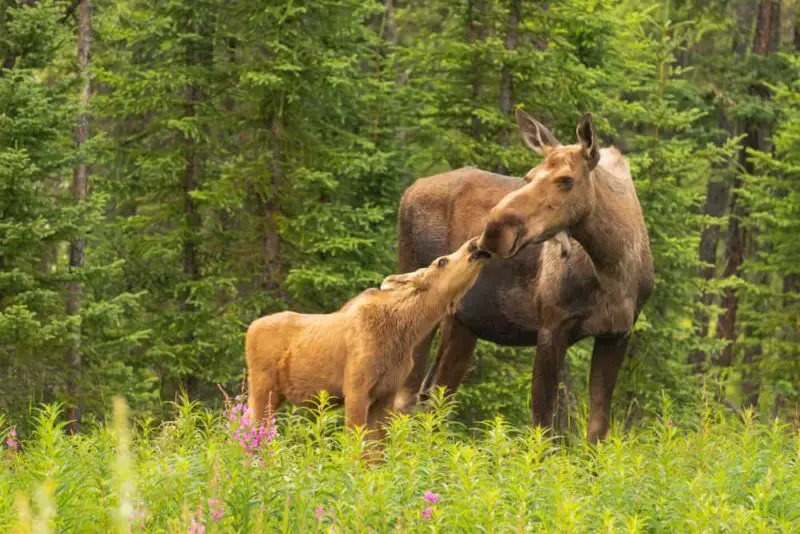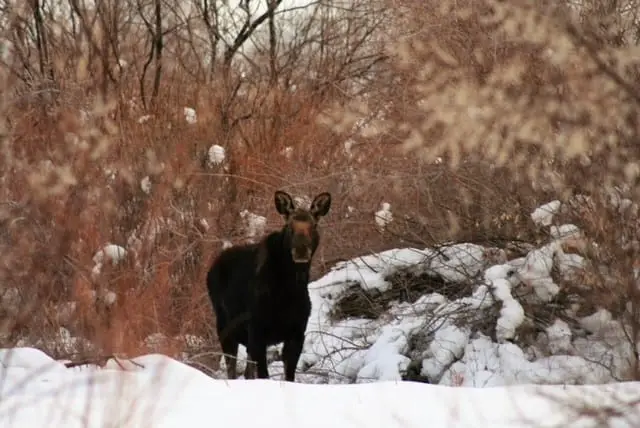According to the Wisconsin Department of Natural Resources, the state’s moose population ranges somewhere between 20 and 40 animals. This number fluctuates, depending on the time of year. This is due to the fact that some of these animals migrate between Wisconsin and Michigan’s upper peninsula. To be sure, this isn’t a large population, but for a time, moose were extirpated from the state.
Before the time of European settlement in North America, moose, which are the largest member of the deer family in the world, ranged through most of the boreal forests in North America. This includes at least the northern 1/2 of Wisconsin, primarily above the 44-degree latitudinal line.
Moose was fairly common in that part of the state through the mid and late eighteen hundreds. However, due to overhunting and degradation of their habitat, they had disappeared from the state by the early twentieth century. The last known killing of a native moose in Wisconsin by a hunter took place in 1921.
The return of moose to Wisconsin
A few isolated moose began to be seen in Northern Wisconsin in the mid-1900s. It was after the Michigan DNR began its initial moose reintroduction efforts in the 1930s, where they captured moose from an island in Lake Superior called Isle Royale and introduced them to the upper peninsula of Michigan, that verified moose sightings began to occur in Wisconsin.
In the 1960s, people began to occasionally see moose again in northwestern Wisconsin. These animals are thought to be wanderers from Minnesota. The timing coincides with when Minnesota’s moose population was peaking.

Why doesn’t the Wisconsin DNR try to bring moose back?
In 1989, the Wisconsin State Legislature instructed the Wisconsin Department of Natural Resources to explore the possibility of reintroducing elk, moose, and caribou into the state. In their published report, titled “Feasibility Assessment for the Reintroduction on North American Elk, Moose, and Caribou into Wisconsin”, They determined that while the reintroduction of elk could likely succeed, the reintroduction of moose or caribou would likely fail. See
Lack of suitable moose habitat
According to the report, suitable moose habitat will have 20% shrubs or other young trees that might result from a clearcut or a burn, 5-10% spruce/fir that are more than 20 years old, and 5-10% wetlands.
The report suggested progressive clearcutting to imitate the effects of burns to increase available moose habitat.
Moose and brain worm
High deer numbers are not good for moose. However, white-tailed deer hunting is popular in the state of Wisconsin. Consequently, the state manages its deer herds to accommodate a high hunter demand.
In fact, most of northern Wisconsin has more than 10 white-tailed deer per square mile. The viability of a moose population isn’t very high above this threshold. This is due to the fact that 40 to 70% of the population of whitetail deer in northern Wisconsin carry a parasite called Parelaphostrongylus tenuis, or brain worm.
Brain worms infect the meningeal and neurological tissues in ungulate animals such as deer, elk, and moose. They cause neurological damage, the symptoms of which oftentimes include death.
Although whitetails carry brainworm, they have evolved a high resistance to its symptoms. Unfortunately, moose have not. Consequently, in areas where high concentrations of white-tailed deer are shedding brainworm larvae on the ground through their fecal material, other ungulates, such as moose and elk, are adversely affected.

Attempt to extend endangered species protections to moose in upper mid-western states.
The moose population in Minnesota went into steep decline in the early 2000s. It dropped from an estimated 8,840 animals in 2006 to 2,700 animals in 2013. Consequently, the state of Minnesota canceled its moose hunting season.
Additionally, Collette Adkins, who is an attorney with the Center for Biological Diversity, filed a petition in conjunction with another environmental group called Respect the Earth, to the U.S. Fish and Wildlife Service, to grant the subspecies of moose, (Alces alces andersoni) or Northwestern Moose that inhabits Wisconsin, Michigan, Minnesota, and North Dakota federal protections under the endangered species act.
However, in 2020 federal officials denied the petition filed by the two environmental groups. They reasoned that the current population of the Northwestern subspecies of moose in the four upper midwestern states is stable. An aerial survey in the winter of 2019-2020 showed that although Minnesota’s moose numbers were still down more than 50% since 2006, the animal’s numbers had remained relatively stable for the ninth consecutive year. Furthermore, they stated that there is no biological difference between these moose and similar moose north of the Canadian border, where the population is healthy.
According to U.S. Fish and Wildlife spokeswoman Georgia Parham, in order to extend endangered species protection, they needed to find that the particular population of moose is distinct from any other moose in the region, and they could not find that. See
You might also like
The Wisconsin Department of Natural Resources urges deer hunters in the northern region to be sure of their targets.
The Wisconsin DNR is urging hunters to know the differences between white-tailed deer, elk, and moose. They’re also reminding hunters to be sure of their target before they shoot. Additionally, they state that the accidental shooting of non-target animals may result in a fine and a revocation of your hunting license.
See below for some direct quotes from the Wisconsin DNR website. See
- Although Wisconsin has not reintroduced moose, there are several verified moose sightings across northern Wisconsin each year. A few hunters may even be lucky enough to see one this fall.
- Once widespread across North America, elk were eliminated from Wisconsin in the 1880s. Thanks to the support of many partners and the backing of Wisconsinites, elk were reintroduced within the state in 1995. Through DNR efforts to reestablish the species, the elk herd continues to expand, making it essential for hunters to know their target to protect this growing population.
- Currently, there are two herds containing a total of more than 400 elk in Wisconsin reintroduction areas: one in the north, including Ashland, Bayfield, Price, Rusk, and Sawyer counties, and one in the area surrounding Jackson County. Occasionally, elk can roam beyond these areas, so it is important for deer hunters statewide to be sure of their target.
- Learn about the differences between elk and white-tailed deer below using the DNR’s comparison guide.
- Hunters should follow all firearm safety rules and be sure of their target and what is beyond it. Positively identifying the target ensures the safety of other people and avoids the accidental shooting of non-target animals.
Recent Posts
The only venomous snakes in Washington State are Northern Pacific Rattlesnakes. The Northern Pacific Rattlesnake (Crotalus oreganus oreganus) is a sub-species of the Western Rattlesnake. Anyone...
Skunks are not classified as true hibernators. But they go into a state of torpor when the weather gets cold. Skunks are light sleep hibernators, along with opossums, bears, and raccoons. ...

